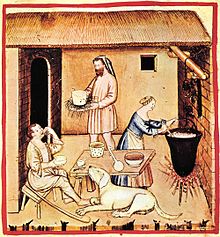History of cheese

The production of cheese predates recorded history, beginning well over 7,000 years ago.[1][2][3] Humans likely developed cheese and other dairy foods by accident, as a result of storing and transporting milk in bladders made of ruminants' stomachs, as their inherent supply of rennet would encourage curdling. There is no conclusive evidence indicating where cheese-making originated, possibly Europe, or Central Asia, the Middle East, or the Sahara.
Earliest origins[]
The earliest direct evidence of cheesemaking is now being found in clay sieves (holed pottery) over seven thousand years old, for example in Kujawy, Poland,[4] and the Dalmatian coast in Croatia, the latter with dried remains which chemical analysis suggests was cheese.[1][2][3] Shards of holed pottery were also found in Urnfield pile-dwellings on Lake Neuchatel in Switzerland and are hypothesized to be cheese-strainers;[5] they date back to 6,000 BCE (8,000 years ago).[6]
For preservation purposes, cheese-making may have begun by the pressing and salting of curdled milk. Animal skins and inflated internal organs already provided storage vessels for a range of foodstuffs. Curdling milk in an animal's stomach made solid and better-textured curds, which could easily have led to the conscious addition of rennet.
Hard salted cheese is likely to have accompanied dairying from the outset. It is the only form in which milk can be kept in a hot climate. Dairying existed around 4,000 BC in the grasslands of the Sahara.[7] Cheese produced in Europe, where climates are cooler than in the Middle East, required less salt for preservation. With less salt and acidity, the cheese became a suitable environment for useful microbes and molds, giving aged cheeses their pronounced and interesting flavors.
The earliest written evidence of cheese (GA.UAR) is the Sumerian cuneiform texts of Third Dynasty of Ur, dated at the early second millennium BC.[8] The earliest cheeses were sour and salty and similar in texture to rustic cottage cheese or present-day feta. In Late Bronze Age Minoan-Mycenaean Crete, Linear B tablets recorded the inventorying of cheese, (Mycenaean Greek in Linear B: